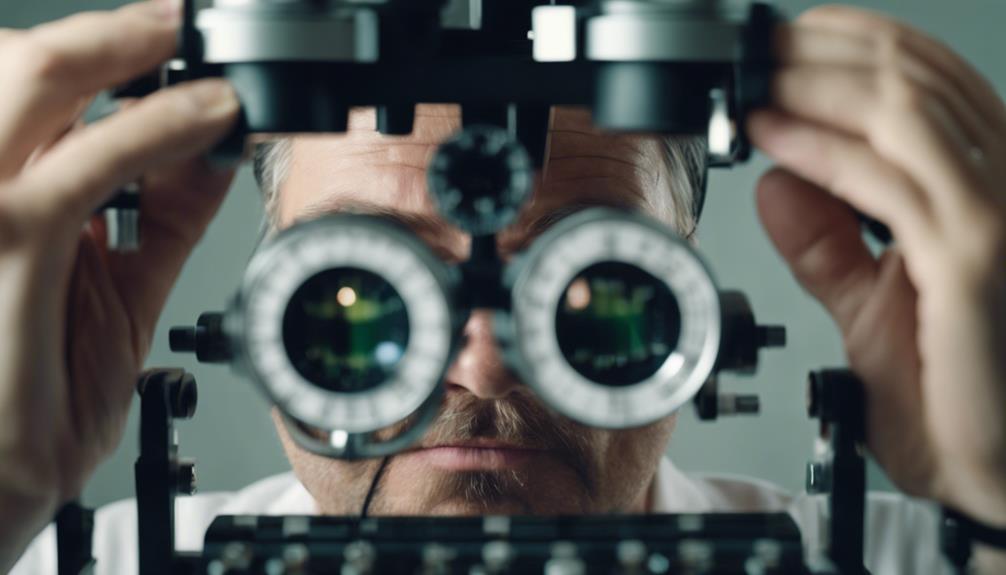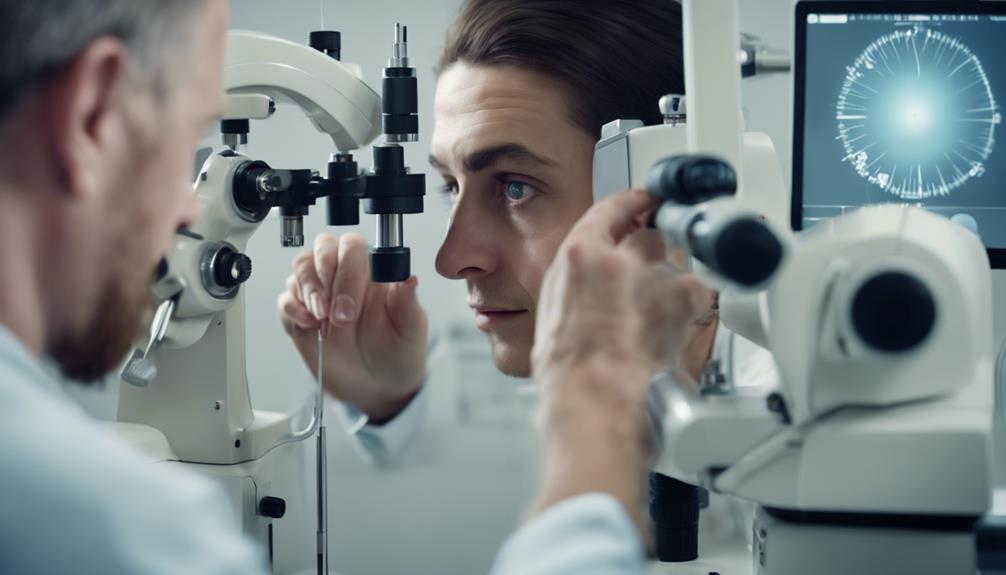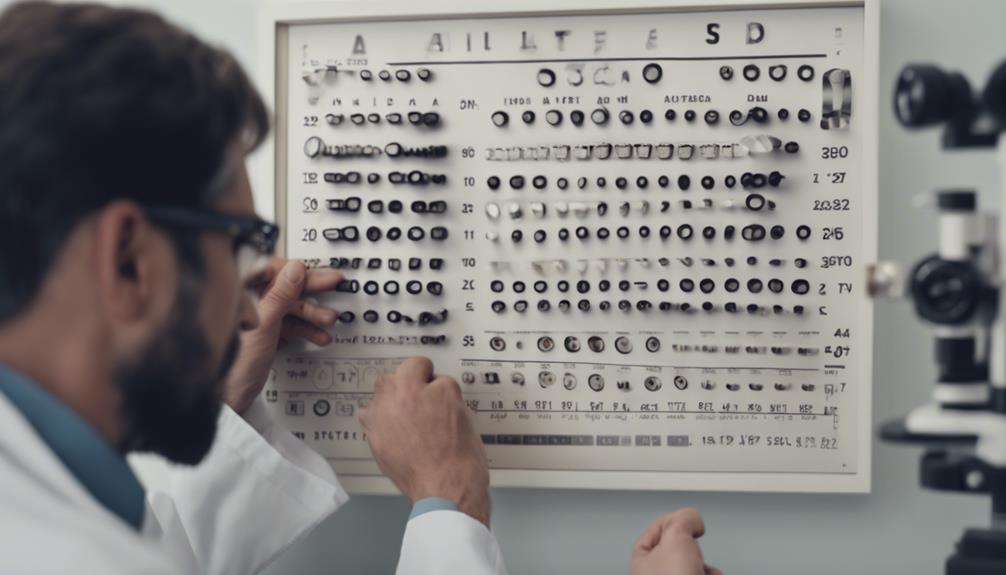Astigmatism testing is crucial for detecting irregularities in corneal or lens shape, aiding in tailored treatment. Tests like refraction, visual acuity, and keratometry play a significant role in pinpointing issues for precise correction. These exams help professionals understand light refraction on the retina and monitor changes in visual acuity over time. Early detection through testing allows interventions to enhance vision quality. For further insights on how astigmatism testing works and its implications for eye health, exploring detailed information can offer a deeper understanding of this essential diagnostic process.
Key Takeaways
- Astigmatism tests diagnose irregular cornea/lens shape.
- Tests like refraction, keratometry determine correction needs.
- Early detection allows timely treatment interventions.
- Visual acuity, corneal curvature tests are crucial.
- Regular testing monitors changes for optimal vision care.
Understanding Astigmatism
Astigmatism results from an irregular shape of the cornea or lens, causing light to scatter rather than focus correctly on the retina. This irregular shape distorts the way light enters the eye, leading to blurred vision, double vision, eyestrain, headaches, fatigue, night vision difficulties, and squinting.
To diagnose astigmatism, visual acuity tests, keratometry, corneal topography, and refraction are commonly used by eye care professionals.
Astigmatism can be present from birth and is categorized into regular and irregular types based on the corneal or lens shape. When astigmatism is diagnosed, glasses or contact lenses are typically prescribed for corrections. The prescription is tailored to the degree and axis of astigmatism, with a diopter measurement of 1.5 or more often indicating the need for corrective lenses.
For accurate diagnosis and treatment of astigmatism, consulting an eye care professional is crucial. They can provide the necessary tests and guidance to make sure that the condition is properly managed to improve vision and overall eye health.
Importance of Astigmatism Testing

Astigmatism testing plays a crucial role in identifying and addressing vision problems related to irregular corneal or lens shape. By conducting tests like refraction, visual acuity, and keratometry, eye care professionals can pinpoint the degree and axis of astigmatism for precise correction.
Early detection through astigmatism testing allows for timely interventions such as glasses, contacts, or refractive surgery, highlighting the importance of regular eye exams for maintaining excellent eye health and clear vision.
Testing for Astigmatism
Evaluating for astigmatism is a crucial element of thorough eye exams to guarantee precise diagnosis and suitable treatment. Astigmatism tests, such as visual acuity exams, keratometry, and evaluating cornea curvature, are integral in determining the severity and orientation of astigmatism for accurate vision correction. These tests help eye care professionals understand how light refracts onto the retina, enabling them to prescribe the appropriate corrective measures.
Regular eye exams that include astigmatism testing are essential to monitor changes in visual acuity and to adjust treatments as necessary to maintain excellent eye health. By assessing corneal curvature and overall eye health, a detailed astigmatism test ensures a thorough assessment that goes beyond just vision correction. Early detection through these tests allows for timely interventions to improve the quality of vision and prevent further complications.
Early Detection Benefits
Why is early detection through astigmatism testing important for maintaining peak vision health?
Early detection of astigmatism can play a significant role in preserving excellent eye health. Here are four key reasons why timely astigmatism testing is beneficial:
- Preventing Vision Problems:
Identifying astigmatism early on allows for timely correction, preventing potential vision issues that can hinder daily activities.
- Addressing Refractive Errors:
Astigmatism testing is essential in pinpointing refractive errors that may otherwise go unnoticed and impact the quality of one's vision.
- Determining Severity and Treatment:
Through astigmatism testing, healthcare providers can assess the severity of the condition and recommend appropriate treatment options tailored to individual needs.
- Promoting Overall Eye Health:
Regular astigmatism testing not only aids in managing visual disturbances but also helps in maintaining good eye health by preventing the progression of any underlying issues.
Refraction Test Overview

During a refraction test, optometrists evaluate how well an individual's eyes focus light to determine the appropriate prescription for corrective lenses. This test is important in diagnosing conditions like astigmatism and ensuring that your vision is clear and sharp.
Typically conducted as part of a thorough eye exam, the refraction test involves looking through a device called a phoropter and providing feedback on which lenses improve your vision. Optometrists use an eye chart with different lenses to measure your refractive error, which is then recorded in diopters.
Visual Acuity Assessment

Visual acuity evaluation is a fundamental component of an eye examination. It gauges an individual's ability to discern fine details at different distances. By utilizing an eye chart, practitioners can appraise a person's vision clarity by evaluating their capability to identify letters or symbols accurately.
This evaluation is often expressed as a fraction like 20/20. It is pivotal in determining the appropriate corrective lenses or treatment required to address any visual impairments detected.
Vision Clarity Measurement
Measuring vision clarity involves evaluating how well an individual can see details at various distances, such as reading an eye chart. Here are four key points about vision clarity measurement:
- Results from visual acuity assessments are typically expressed as a fraction, like 20/20 vision, which compares your clarity to a standard. This measurement is important in determining the impact of conditions like astigmatism and other refractive errors on your vision quality.
- Visual acuity tests play a significant role during eye exams to assess whether corrective lenses or vision correction procedures are needed. By identifying the smallest letters or symbols that can be accurately read, these tests help gauge your level of visual acuity.
- Understanding your visual acuity is crucial for maintaining good eye health and ensuring excellent vision performance in daily activities. Regular visual acuity assessments can help detect changes in your vision and guide appropriate treatment options.
- By accurately measuring vision clarity, individuals can address potential vision issues promptly, allowing for better management of conditions affecting visual acuity.
Eye Chart Examination
Eye chart examinations assess an individual's visual acuity by testing their ability to see clearly at different distances. These tests involve reading lines of varying sizes and letters on an eye chart to determine the sharpness and clarity of one's vision.
The results, often expressed as a ratio like 20/20, help identify refractive errors such as astigmatism. The Snellen chart, a widely used tool in visual acuity assessments, features letters that decrease in size as you move down the chart, indicating better vision at the top and potentially poorer vision towards the bottom.
Keratometry Examination Process

The keratometry examination process involves measuring the curvature of the cornea to accurately detect astigmatism. This diagnostic test compares the corneal meridians to a clock face, identifying any unequal curves that may cause astigmatism.
Unequal curves in different meridians can result in light bending unevenly as it enters the eye, leading to blurry vision. Keratometry is a vital step in the diagnosis of astigmatism during a thorough eye exam, helping eye care professionals determine both the degree and axis of astigmatism for appropriate correction.
- The keratometry test measures the curvature of the cornea, which is the clear front surface of the eye.
- By comparing corneal meridians to a clock face, the test reveals any irregularities in the corneal curvature.
- Unequal curves in different meridians can cause light to focus improperly on the retina, resulting in distorted vision.
- Keratometry is an essential tool for eye care professionals to precisely diagnose and treat astigmatism.
At-Home Test Options

At-home astigmatism tests offer individuals a convenient self-assessment method using specialized eye charts. These eye charts are designed for self-evaluation, typically requiring individuals to cover one eye and focus on specific lines or patterns. By observing the boldness and thickness of lines on the chart, individuals can get an indication of potential astigmatism. While at-home tests can suggest the presence of astigmatism, it is crucial to follow up with an eye doctor for confirmation. Optometrists are trained professionals who can provide accurate diagnoses and recommend appropriate treatment options based on the test results.
| Aspect | Details |
|---|---|
| Usage | Self-assessment |
| Focus | Specific lines or patterns |
| Indicator of Astigmatism | Boldness and thickness of lines on the chart |
| Follow-up | Essential to confirm diagnosis with an eye doctor |
Reliability of Online Tests

Online astigmatism tests can provide a thorough assessment but shouldn't replace professional eye exams. While these at-home screening methods can suggest the presence of astigmatism through special eye charts, their reliability in providing an accurate diagnosis is limited.
Here are some key points to contemplate regarding the reliability of online tests:
- Supplementary Tool: Online tests can serve as a supplementary tool to help identify potential symptoms of astigmatism.
- Not All-Encompassing: These tests aren't a substitute for a thorough eye exam conducted by a professional eye care provider.
- Follow-up Necessary: Confirmation and accurate diagnosis of astigmatism require follow-up with an eye care provider who can offer a more in-depth evaluation.
- Treatment Recommendations: Optometrists can recommend appropriate treatment options, such as corrective lenses or surgery, based on the results of a thorough eye exam, ensuring the best possible outcome for the patient.
Interpreting Test Results

Understanding and accurately interpreting astigmatism test results is vital for determining appropriate treatment options and personalized care. Test results provide essential information about the degree of astigmatism, measured in diopters, and the axis measurement, which indicates the orientation of the irregular corneal shape.
By interpreting these results correctly, eye care professionals can assess the severity of astigmatism and tailor treatment plans accordingly. Whether it involves prescribing corrective lenses or recommending surgical interventions, the interpretation of test results plays a significant role in managing astigmatism effectively.
For individuals with astigmatism, the accuracy of interpreting test results can make a difference in the outcome of their vision correction. Personalized care, based on a thorough understanding of the test results, ensures that the chosen treatment addresses the specific needs of each patient.
Follow-Up Care After Testing

Following the completion of astigmatism testing, individuals should schedule regular follow-up appointments with an eye doctor to monitor their condition and receive personalized treatment recommendations. This follow-up care is vital for guaranteeing an accurate diagnosis and effective management of astigmatism.
Here are four key points to take into account:
- Consultation with an Eye Doctor: Schedule a consultation to discuss test results and determine the severity of astigmatism. This discussion will lay the foundation for personalized treatment options.
- Personalized Treatment Recommendations: Eye care professionals can provide tailored treatment plans based on test findings. These recommendations are essential for managing astigmatism effectively.
- Regular Follow-Up Appointments: Monitoring changes in astigmatism through regular follow-up visits allows for tracking vision progress and making adjustments to treatments as needed.
- Thorough Management: Opting for professional care ensures thorough management of astigmatism and other vision issues identified during testing. Regular follow-up care is key to maintaining excellent eye health and vision clarity.
Frequently Asked Questions
How Does an Astigmatism Test Work?
An astigmatism test assesses visual acuity, refraction, and corneal curvature to diagnose irregularities in the eye's shape. It determines the degree and axis of astigmatism, essential for prescribing accurate corrective lenses or planning surgeries.
What Is Astigmatism and How Is It Measured?
Astigmatism is a common refractive error caused by an irregular cornea or lens shape, leading to blurry vision. It is measured in diopters, with higher values indicating more severe astigmatism. Testing involves refraction, visual acuity, and keratometry.
What Is the Main Cause of Astigmatism?
What causes astigmatism? Irregular cornea or lens shape scatters light, preventing focused vision. Factors like injuries and conditions can also contribute. Understanding these causes aids in proper diagnosis and treatment, correcting the refractive error effectively.
How Do I Know What My Astigmatism Is?
To determine their astigmatism, individuals should undergo an eye exam with an eye doctor. The doctor will perform tests like visual acuity and keratometry to measure the degree and axis of astigmatism, prescribing corrective lenses as needed.
Conclusion
To sum up, astigmatism testing is an essential step in maintaining good eye health. By undergoing a refraction test, visual acuity assessment, and keratometry examination, individuals can identify and address any astigmatism issues.
While at-home test options exist, it's important to consult with an eye care professional for accurate results and follow-up care.
Remember, seeing clearly isn't just a matter of perception, but a reflection of the care we give to our eyes.









